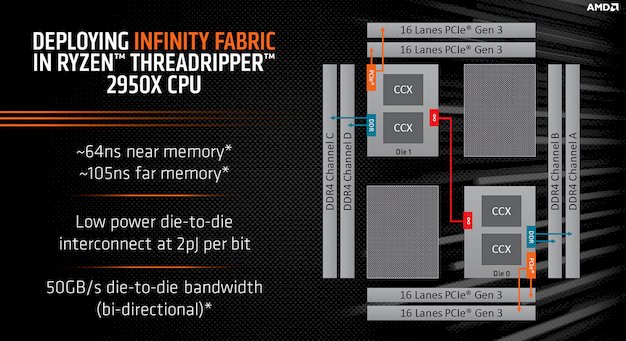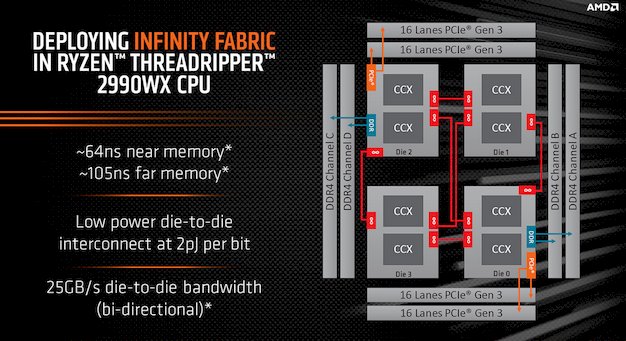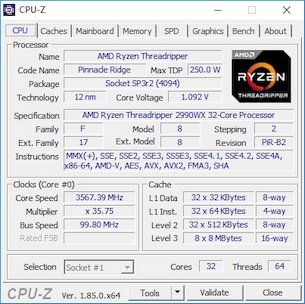AMD 2nd Gen Ryzen Threadripper 2950X And 2990WX Review: Beastly Zen+ Many-Core CPUs
With the introduction of its original Ryzen processors though, AMD made highly competitive six and eight-core desktop processors available to mainstream users and later pushed the HEDT segment all the way up to 16 cores (32 threads) with Threadripper, with a top-shelf price just shy of $1000. To put it simply, AMD made many more, and much faster, cores available to users at lower, more aggressive price points than ever before. As a result, Intel reacted and we find ourselves in the situation we are in today where 6 and 8 core processors are mainstream, at price points that were unheard of not too long ago.
Today, AMD is officially unveiling its 2nd Generation Ryzen Threadripper processors and it hopes to scale things up even further than it did last year. There’s only so much wiggle-room left in the enthusiast segment, so with this launch AMD has also set its sights on content creation and workstation professionals, with processors that feature 24 and 32 Zen+ cores. The Threadripper WX series is somewhat of a departure from the original Threadrippers, but their massive compute capabilities and aggressive price points (relatively speaking) may prove to be highly attractive to creators that can never have enough horsepower. The Threadripper X-series gets a significant boost from the Zen+ architecture as well, however. The goal with this round of Threadrippers is to offer a better experience than the originals all-around, while also offering more performance, and maintaining full platform compatibility.
|
Like their more mainstream desktop counterparts, all of the 2nd Generation Ryzen Threadripper processors have a number of features and aspects in common. All of the processors are manufactured using the same 12nm process and leverage AMD’s Zen+ architecture. Although they are second generation CPUs, these processors are not based on the true, next-gen Zen 2 architecture – that’s coming later. All of the 2nd Generation Ryzen Threadripper processors feature the enhanced boost algorithm that came with Zen+ that is more opportunistic and can boost more cores, more often, and they also offer higher-clocks, lower-latency, and are somewhat more tolerant of higher memory speeds, though DDR4-2933 remains the max “official” memory clock, without overclocking.
If you’d like a refresher on what makes AMD’s Ryzen processors tick, and all of the enhancements that came with Zen+, we suggest checking out a handful of past articles. Our launch coverage of the original Ryzen and Threadripper processors lays the foundation for what we’ll be showing you here today, and our coverage of AMD’s 2nd Generation Ryzen processors explains what Zen+ brings to the table. We suspect most of you know what these 2nd Generation Threadrippers are all about, but if you’re not hip to what AMD has been up to the last year or so, those articles will fill you in.
AMD is selecting the very best processor dies for its 2nd Gen Ryzen Threadripper chips. Like the originals, only the top 5% of dies make into 2nd Gen Threadrippers, in an attempt to ensure its flagship consumer processor line-up delivers the goods. All of the processors are also multi-chip modules that leverage multiple 8-core die, with each die consisting of two, quad-core CCXes (Compute Complexes). The 16-core 2950X has two active, 8-core dies, while the 32-core 2990WX has four active, 8-core dies. The 12-core 2920X and 24-core 2970WX that are coming later have similar die counts as their counterparts, but with 1-core disabled per CCX.
A key component of Threadripper (and many other AMD products) is the Infinity Fabric. Infinity Fabric is a scalable control and data fabric in Threadripper (and other AMD CPUs and GPUs) that is responsible for all of the intra- and inter-core communications. With Threadripper, every die can talk to every die, but with the WX series we must note that because the fabric configuration is symmetrical and there are twice as many dies to consider, the bandwidth per die has been cut in half to 25GB/s, assuming a 1600MHz memory clock (50GB/s of bandwidth is available between dies on the dual-die parts). This is a particularly important note because the die and memory configuration on WX-series Threadrippers affects how they operate and ultimately how they will perform with various workloads.
Whereas the 12-core Ryzen Threadripper 2920X and 16-core 2950X maintain the dual-die configuration of the originals, with two memory channels connected per die, two of the dies in the quad-die 24-core 2970WX and 32-core 2990WX do not have memory attached. That means the Threadripper WX-series processors – assuming all cores / dies are active – will always function as NUMA systems (Non-Unified Memory Architecture). The dual-die processors can be configured as NUMA or UMA -- we have additional detail in Threadripper's NUMA and UMA modes here.
The memory configuration on the Threadripper 2970WX and 2990WX will undoubtedly result in higher latency in some situations, when workloads spill out onto the processor cores / dies without memory attached. Highly-threaded workloads are often very tolerant of this additional latency because the actual compute performance may be the bottleneck, but this will not always be the case. With that said, users can quickly and easily disable cores / dies through the AMD Ryzen Master Utility, and make WX-series Threadrippers behave much like the 2920X and 2950X (and enable UMA or NUMA configurations), but at the expense of at least half of the compute performance, obviously. As you’ll see a later, throughout our testing, a couple of applications exhibited anomalous performance with all cores active on the Threadripper 2990WX, so we re-ran the tests with half of the cores disabled and performance jumped right back up to expected levels.
AMD configured the memory channels on the Threadripper WX-series in this way to maintain platform compatibility. Because of their similarity to EPYC server processors, AMD could have technically outfitted the WX-series with eight memory channels, but that would have required new motherboards. X399 motherboards can accommodate four memory channels, so that’s what the processors got.
As mentioned, applications that do scale beyond 16 cores are often tolerant of the latency issues associated with the new WX-series configuration. This is not going to be universally true, and some workloads will falter with the latency hit associated Threadripper WX-series’ topology, but on a single user desktop system, AMD was willing to take the hit to maintain compatibility with existing platforms, which are fairly mature at this point. Keeping the ecosystem stable is a primary focus for AMD and the company didn’t want to start over with the WX-series.
AMD's Ryzen Threadripper processors feature 512K of L2 cache per core (8MB total on the 2950X and 16MB on the 2990WX), quad-channel memory controllers (2+2), and are outfitted with 64 integrated PCI Express Gen 3 lanes. The massive amount of IO connectivity in Threadripper is something AMD has been vocal about, not only because it’s more than Intel offers in its Core-X family, but because the total number of integrated lanes will not vary from Threadripper to Threadripper, whereas lower-end Core series processors may offer fewer lanes than the higher-end parts. The Ryzen Threadripper 2950X has a 180W TDP, while the 2990WX has a beefier 250W TDP.
CPU-Z details for both the Threadripper 2950X and 2990WX are shown above. You’ll notice that the only thing that changes from CPU to CPU is the core count and hence the total amount of L1 and L2 cache. Instruction and feature support is identical, and matches the other 2nd Generation Ryzen processors, which is expected, considering they all leverage the exact same die. As for their clocks, the Threadripper 2950X has a base clock of 3.5GHz and max turbo frequency of 4.4GHz, while the 2990WX has a 3.0GHz base clock and boosts up to 4.2GHz.
Like the originals, AMD went all-out on its 2nd Generation Ryzen Threadripper packaging. The chips come packed inside large containers made of a rigid foam, with a faceted center section and transparent windows, front and back. The container comes apart to reveal a stylized plastic case, which holds the processor inside.
There’s also a small box tucked away at the bottom that contains a basic lit-pack with an AMD Ryzen Threadripper decal, a mini-Torque wrench (with a Torx tip) for installing the CPU into its socket, and a metal bracket, which is compatible with all Asetek-built AIO liquid coolers that have circular pump / cold plate assemblies – basically the same tool and mount bundle as the originals.














